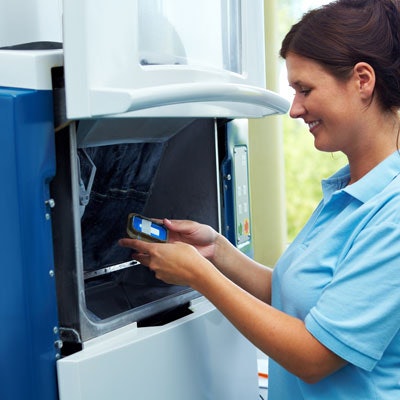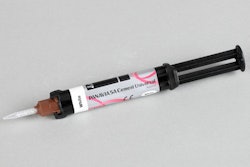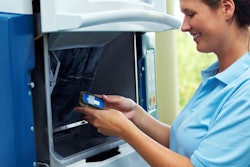
What's the best combination of resin-ceramic CAD/CAM materials with adhesive resin cements? Is it better to go with self-etch or etch-and-rinse cements?
Researchers from Switzerland set out to answer that question for two resin-ceramic CAD/CAM materials: Lava Ultimate (3M ESPE) and Vita Enamic (Vita Zahnfabrik).
"Considering the wide variety of cement types on the market and that a certain cement will already be in use by dental practitioners when they start working with Lava Ultimate or Vita Enamic, it seems relevant to determine how sensitive the two resin-ceramic materials are to cementation over time," wrote lead study author Simon Flury, Dr. med. dent., and colleagues from the University of Bern School of Dental Medicine (Dental Materials Journal, August 20, 2016).
5 cements
For both resin-ceramic materials, the manufacturers recommend a self-etch adhesive resin cement. Lava Ultimate's manufacturer recommends RelyX Ultimate in combination with the self-etch adhesive system Scotchbond Universal (3M ESPE), while Vita Enamic's manufacturer recommends Panavia F2.0 in combination with the self-etch adhesive system ED Primer II.
The researchers used a shear bond strength (SBS) test to investigate the dentin bond strength of the two materials when cemented with two self-etch and two etch-and-rinse adhesive resin cements, plus a glass ionomer cement (Ketac Cem Plus (3M ESPE) as a negative control. They hypothesized that there would be no effect of resin-ceramic material, cement, or storage time on the bond strength to dentin. They measured dentin bond strength after 24 hours and after six months of storage.
The study included 300 extracted human molars divided into groups of 15, with 20 different groups in total for the two resin-ceramic materials and five cements. Lava Ultimate and Vita Enamic were each cemented to the midcoronal dentin of the molars with one of the five cements:
“Considering the wide variety of cement types on the market ... it seems relevant to determine how sensitive the two resin-ceramic materials are to cementation over time.”
- RelyX Ultimate (3M ESPE)
- Panavia F2.0 (Kuraray)
- Variolink II (Ivoclar Vivadent)
- Els cem (Saremco Dental)
- Ketac Cem Plus (3M ESPE)
After storage of either 24 hours or six months at 37° C and 100% humidity, specimens were subjected to SBS testing by use of a wire (stainless steel, diameter of 0.6 mm) and were then analyzed.
Shear bond strength varied markedly between Lava Ultimate and Vita Enamic, among the five cements, and between storage of either 24 hours or six months, the researchers found. The bond strength was highest after six months when Lava Ultimate was cemented with RelyX Ultimate and when Vita Enamic was cemented with RelyX Ultimate or Variolink II. Lava Ultimate also was "somewhat more sensitive to storage" than Vita Enamic, they added.
Of the four adhesive resin cements, Els cem had the significantly lowest SBS compared with the other three adhesive resin cements (all p < 0.0001), followed by the glass ionomer cement Ketac Cem Plus, which showed the significantly lowest SBS of all five cements (p < 0.0001).
Based on their findings, the researchers concluded the following:
- Lava Ultimate was somewhat more sensitive to cementation over time than was Vita Enamic.
- Lava Ultimate restorations should be cemented with RelyX Ultimate.
- Vita Enamic restorations should be cemented with RelyX Ultimate or Variolink II.
The table below shows the conditions under which the resins failed. For Lava Ultimate, the most frequent failure mode was adhesive failure between dentin and cement for the four adhesive resin cements. For Vita Enamic, the most frequent failure mode was adhesive failure between dentin and cement, regardless of storage time. For the glass ionomer cement, the most frequent failure mode was adhesive failure between cement and resin-ceramic material. The percentage of mixed failures increased after six months.
| Conditions under which resins failed for Lava Ultimate | ||||
| Storage (n = 15) |
Cohesive failure in dentin (%) | Adhesive failure dentin-cement (%) | Mixed failure (%) | |
| RelyX Ultimate | 24 hours | 33 | 47 | 20 |
| 6 months | 47 | 13 | 40 | |
| Panavia F2.0 | 24 hours | 0 | 93 | 7 |
| 6 months | 0 | 53 | 20 | |
| Variolink II | 24 hours | 0 | 100 | 0 |
| 6 months | 0 | 87 | 13 | |
| Els cem | 24 hours | 0 | 100 | 0 |
| 6 months | 0 | 93 | 7 | |
| Ketac Cem Plus | 24 hours | 0 | 13 | 0 |
| 6 months | 0 | 20 | 27 | |
After 24 hours, Panavia F2.0 had a 27% adhesive failure rate. Ketac Cem Plus had an 87% adhesive failure rate over the same time period and a 53% failure rate after six months of storage, according to the study authors.
| Conditions under which resins failed for Vita Enamic | ||||
| Storage | Cohesive failure in dentin (%) | Adhesive failure dentin-cement (%) | Mixed failure (%) | |
| RelyX Ultimate | 24 hours | 27 | 46 | 27 |
| 6 months | 7 | 40 | 53 | |
| Panavia F2.0 | 24 hours | 0 | 100 | 0 |
| 6 months | 0 | 87 | 13 | |
| Variolink II | 24 hours | 0 | 100 | 0 |
| 6 months | 0 | 87 | 6.5 | |
| Els cem | 24 hours | 0 | 100 | 0 |
| 6 months | 0 | 87 | 13 | |
| Ketac Cem Plus | 24 hours | 0 | 93 | 0 |
| 6 months | 0 | 80 | 20 | |
Can bond strength increase?
The shear bond strength of RelyX Ultimate actually increased during storage and was significantly higher than the SBS of any other adhesive resin cement after six months, which contradicts previous studies looking at the bond strength of self-etch adhesive systems in combination with resin composites/cements, according to the authors. They speculated that the storage condition was not as challenging as being immersed in water, and the increase might be attributed to postcuring effects of the adhesive resin cement.
"Bearing in mind that the present study included a limited selection of cements on the market, the results obtained with Lava Ultimate lend support to the manufacturer's recommendation of the adhesive resin cement RelyX Ultimate in combination with the 'self-etch' adhesive system Scotchbond Universal," the authors concluded.



















